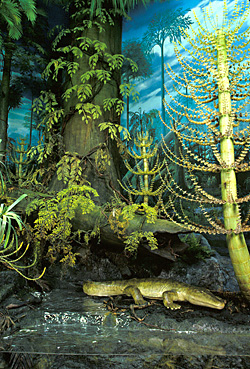 Check the Clue - A Tree or Not a Tree?
Check the Clue - A Tree or Not a Tree?

Illinois State Museum Exhibit
The rain forests that grew in Illinois during the Pennsylvanian Period were dominated by giant lycopods. At 40 meters (about 130 ft.) tall, with trunks several meters (7–10 ft.) in diameter, they were the redwoods of their day. But, were they trees?
Compare Past and Present.
Lycopods were tree-like in many ways. They were
tall, with trunks, branches, leaves, and roots. However, their stems were
made of large, thin-walled
cells. This characteristic shows that they grew rapidly, probably achieving
maximum size in only a few years. Modern trees have woody stems and distinct
annual growth rings.
Conclusion:
Although we call them trees, lycopods were actually more like
weeds than present-day trees. Tree-sized lycopods were distant relatives
of tiny club
mosses. They became extinct in the Permian Period (250 million years ago),
when sea levels fell and worldwide climate became much drier.
Bark Layers
To the left are fossils of bark from lycopods. Each fossil was given a different
name. It took researchers many years to realize that they came from just
two plant genera - Lipodendron and Sigillaria. The trunks of each plant
were layered and each layer had a different pattern. As the lycopod's leaves
dropped off, they left distinctive scars on the bark - spirally arranged,
diamond-shaped scars in Lepidodendron and vertical
rows of geometric scars in Sigillaria.
Present-day Relatives
Modern lycopods, called ground pines or club mosses, resemble small evergreens
or mosses and are only a few centimeters (1–5 in.) tall.